
All iLive content is medically reviewed or fact checked to ensure as much factual accuracy as possible.
We have strict sourcing guidelines and only link to reputable media sites, academic research institutions and, whenever possible, medically peer reviewed studies. Note that the numbers in parentheses ([1], [2], etc.) are clickable links to these studies.
If you feel that any of our content is inaccurate, out-of-date, or otherwise questionable, please select it and press Ctrl + Enter.
Bronchitis pills
Medical expert of the article
Last reviewed: 04.07.2025
Bronchitis is an acute or chronic inflammation of the mucous membrane of the bronchial tree of bacterial or viral origin. The disease develops in the lower respiratory tract. It is usually a complication after influenza or acute respiratory viral infection. There is a classification of bronchitis by the type of inflammatory process in the bronchi:
- Catarrhal (increased formation of exudate in the bronchi);
- Mucopurulent (hyperproduction of exudate in the bronchial tree);
- Purulent (appearance of purulent exudate);
- Fibrinous (the presence of viscous and difficult to separate sputum, which leads to blockage of the lumen of the bronchi and bronchial obstruction);
- Hemorrhagic (due to small hemorrhages in the bronchial mucosa, the presence of blood in the sputum is possible).
Main symptoms: severe persistent cough (dry or with exudate), increased body temperature up to 39 ° C.
Differential diagnosis is made from tuberculosis or pneumonia based on the clinical picture, physical examination and instrumental research methods (chest X-ray).
When treating bronchitis, taking into account the severity of the disease, injection and tablet forms of drugs are used.
There are a huge number of names of tablets for bronchitis (Erespal, Kafetin, Codelac, Stoptussin, Ambrobene, Amizon, Ceftriaxone, Spiramycin, Amikacin, ACC, Mucaltin and many others). All of them are divided into antitussive, expectorant, mucolytic, combined. Each subgroup of drugs also has its own classification. It is very difficult to decide on the choice of the necessary drug.
Cough tablets for bronchitis
Paxeladin, Glaucine, Libexin, Tusuprex, Erespal, etc. The effect of these tablets on the body is not the same - some directly affect the cough center, others weaken or interrupt the impulses going to the brain from the affected bronchial mucosa.
In acute obstructive bronchitis of infectious genesis, antiphlogistic agents are used, which break the main pathogenetic links in the chain of development of inflammatory changes in the respiratory tract. Such a drug is Erespal.
Erespal
Pharmacodynamics: active ingredient fenspiride. It has an antiphlogistic effect and also relieves spasms. It relieves swelling and reduces the intensity of irritation in the bronchial tree, suppresses the secretion of excess mucus.
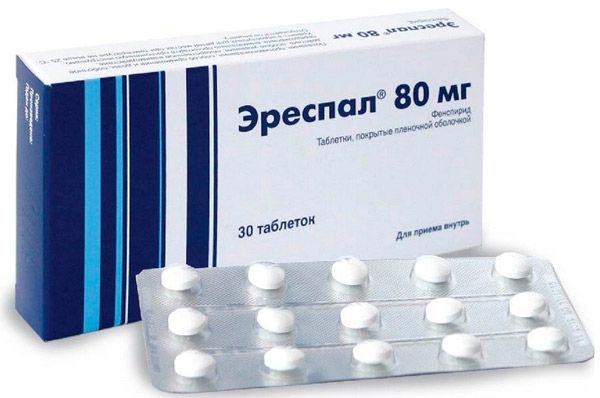
Pharmacokinetics. Fenspiride reaches maximum values in the systemic bloodstream within 6 hours. Metabolic products are excreted by the kidneys with urine within 12 hours.
Use during pregnancy. It is not recommended to use during gestation. Erespal therapy is not an indication for termination of pregnancy.
Contraindications:
- hypersensitivity to the constituent ingredients;
- children under 18 years of age;
- gestation time;
- breastfeeding period.
Side effects. Regarding the gastrointestinal tract – discomfort in the epigastric region, gastralgia, diarrhea, vomiting attacks; regarding the central nervous system – general weakness, lethargy, vertigo; regarding the cardiovascular system – increased heart rate; general symptoms – decreased blood pressure, weakness, fatigue; allergic manifestations – erythematous rash, urticaria, burning, angioedema. All side effects disappear when the dose is reduced or the drug is discontinued.
Method of administration and dosage. 80 mg (1 tab.) 2 or 3 times a day. Max. dosage 240 mg/day. Duration of therapy is determined by the doctor.
Overdose. Exceeding the maximum daily dose does not increase the effectiveness of the drug. Accidental exceeding the maximum therapeutic dose requires immediate medical attention if the following symptoms occur - tachyarrhythmia, nausea, vomiting, apathy or severe agitation. Therapeutic measures: gastric lavage, ECG dynamics and ensuring vital functions of the body.
Interaction with antihistamines, sedatives and analgin-containing drugs leads to an increase in the hypnotic effect. Alcohol intake is strictly prohibited.
Storage conditions: It is recommended to store in a dry, dark place, inaccessible to children, with a temperature below 15 ° C.
The shelf life, according to the instructions, is 36 months.
Cough tablets for bronchitis
In case of bronchitis, there is a need to suppress the excitability of the cough center, as well as to help the body cope with inflammation, lower the temperature. In this situation, cough tablets for bronchitis will come to the rescue - Caffetin, Codelac, Glaucine, Paxeladin, Stopussin, Ambrobene and others.
 [ 1 ]
[ 1 ]
Caffetin
Pharmacodynamics. The drug is combined, its action is determined by the ingredients. Active substances:
- Paracetamol (analgesic and antipyretic from the anilide group) – analgesic, anti-inflammatory, antipyretic effect.
- Caffeine (purine alkaloid) – has a stimulating effect on the central nervous system, reduces fatigue, enhances the effect of analgesics, increases blood pressure, and increases heart rate.
- Codeine (opium alkaloid) – suppresses the excitability of the cough center, has an analgesic effect.
- Propyphenazone (an analgesic and antipyretic from the pyrazolone group) has an antipyretic and analgesic effect.
Pharmacokinetics. All active ingredients of the drug are well absorbed in the gastrointestinal tract. The maximum concentration in the bloodstream of paracetamol is achieved in 2.5-2 hours; caffeine - in 0.4-1.4 hours; codeine - 2-4 hours. Propyphenazone - 30 min. Broken down by the liver. Paracetamol is excreted by the kidneys in the form of conjugates (sulfites and glucuronides). Caffeine is excreted by the kidneys. 3-methylmorphine and 1,5-dimethyl-2-phenyl-4-propan-2-lpyrazol-3-one are excreted by the kidneys and bile.
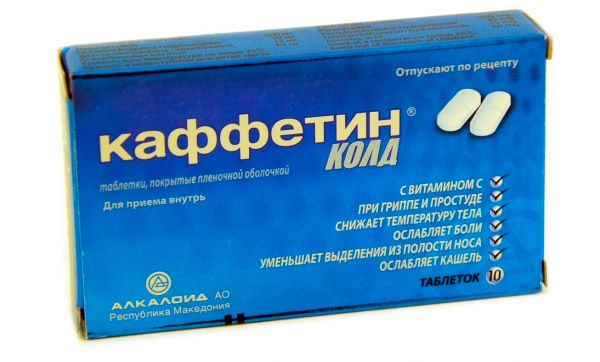
Method of administration and dosage: the planned intake for adults is 1 tablet, 3-4 times a day, in case of intense pain it is possible to take 2 tablets at the same time. Max. daily dose is not more than 6 tablets.
For children over 7 years of age: ¼ – ½ tablet 1 to 4 times a day. The standard course of treatment is no more than 5 days.
The duration of the course of therapy and the dosage of the drug are adjusted by the doctor, depending on the diagnosis, taking into account the side effects.
Overdose. Each of the active components of the drug can cause specific symptoms in case of overdose.
- Paracetamol – loss of appetite, pale skin and visible mucous membranes, pain in the epigastrium. Metabolic processes are disrupted, a hepatotoxic effect appears.
- Caffeine – anxiety, headache, hand tremors, tachyarrhythmia, increased blood pressure.
- Codeine - cold clammy sweat, confusion, decreased blood pressure, vertigo, decreased respiratory rate, hypothermia, increased anxiety, seizures.
Treatment of overdose depends on the symptoms and is carried out in a clinic under the supervision of a doctor. Gastric lavage is usually used. Enterosorbents and therapy aimed at eliminating specific symptoms. Symptoms associated with codeine overdose are administered with an antagonist - naloxone.
Interaction with other drugs. Paracetamol: simultaneous use with barbiturates, hypnotics, anticonvulsants, antidepressants, rifalenicin, ethanol, phenibutazone is not recommended due to the high risk of complications in the form of hepatotoxic reactions. With the parallel use of indirect anticoagulants and paracetamol, the risk of prolongation of hemostasis time increases. The use of metoclopramide significantly increases the activity of paracetamol absorption.
Codeine - enhances the sedative properties of CNS depressants, muscle relaxants, ethanol, analgesics. Suppresses the effectiveness of metoclopramide.
Caffeine - simultaneous use with beta-blockers may lead to mutual suppression of the effectiveness of the drugs. Monoamine oxidase inhibitors in combination with caffeine. There is a possibility of provoking arrhythmia and persistent increase in blood pressure. Decreased clearance of xanthines (theophylline) leads to additional hepatotoxic effects. Simultaneous use of purine alkaloids with narcotic and hypnotic drugs significantly reduces the sedative properties of the drugs.
Codelac Broncho
Codelac is a combination drug. Active ingredients: codeine (opium alkaloid), sodium bicarbonate (soda), thermopsis herb, licorice root.

- Codeine is an opium alkaloid derivative. The antitussive effect is based on the suppression of the respiratory and cough centers. Blocks unproductive cough. In the permissible therapeutic dosage, it is not dangerous, does not cause addiction or dependence.
- Soda - facilitates the discharge of sputum by reducing its viscosity, which stimulates more active work of the ciliated epithelium of the bronchi. Changes the acidic environment of bronchial mucus to alkaline.
- Thermopsis herb – increases the level of secretion of the glands of the bronchial tree, activates the work of the ciliated epithelium covering the bronchi. Stimulates the respiratory and vomiting centers.
- Licorice root – contains flavonoids that have antiphlogistic, regenerating, antispasmodic effects. Expectorant and immunostimulating effects. Suppresses the growth of pathogenic microorganisms (staphylococci, mycobacteria, etc.).
Pharmacokinetics. Well and completely absorbed by the gastrointestinal tract. Maximum concentration in blood plasma is observed after 30-60 minutes. Excreted by the kidneys after 6-9 hours.
Method of administration. Adults – 1 tablet twice or three times a day. Single max. dose of 3-methylmorphine – 50 mg. Max. daily dose of the drug – 200 mg. The standard course of treatment usually lasts 3-5 days.
Overdose. Exceeding the doctor's prescribed doses of the drug leads to an overdose of codeine: vomiting, drowsiness, decreased sinus angle function, itchy skin, slow breathing, intestinal and bladder atony.
Gastric lavage and the use of sorbents are prescribed. Symptomatic therapy is performed to correct the normal functioning of organs and systems.
Interaction with other drugs. It is prohibited to use Codellac with drugs that depress the central nervous system (hypnotics, sedatives, central analgesics, tranquilizers, antibiotics). The drug is incompatible with alcohol-containing and antihistamines. The use of cardiotonic drugs in combination with Codellac leads to an increase in their plasma concentrations. Simultaneous administration of astringents and enveloping drugs, enterosorbents with Codellac significantly weakens the effect of its active ingredients. The use of expectorants and mucolytics simultaneously with Codellac contradicts the therapeutic goals of each drug.
Glaucine
Glaucine is an alkaloid obtained from the above-ground part of the herbaceous plant Glaucium flavum (yellow poppy). It has a central antitussive effect. It has a slight vasodilating effect, leading to hypotension. It differs from codeine in that it does not cause suppression of the respiratory center and does not inhibit intestinal motility. Long-term use of the drug does not cause drug dependence and addiction.
Pharmacokinetics. The drug is well absorbed by the gastrointestinal tract. The effect appears after 30 minutes and lasts for 8 hours. The main part is metabolized by the liver. Metabolites are excreted unchanged by the kidneys.
Use during pregnancy. Not recommended for use during gestation.
Application and dosage: adults – 40-50 mg – 2-3 times a day; to suppress coughing fits at night – 80 mg at night; max. daily dose 200 mg; children – from 4 years old: 10-30 mg – 2-3 times a day. The drug is prescribed two or three times a day. Glaucine is taken after meals.
Overdose. The drug is taken according to the scheme prescribed by the doctor. There are no cases of Glaucine overdose. If the patient takes a large number of tablets at once, then in this situation it is necessary to wash the stomach. Deterioration of the condition requires emergency medical care in a hospital setting.
Interaction with other drugs. No incompatibility was observed. There is a positive effect and increased antitussive action if Glaucine is used with ephedrine and basil oil.
Paxeladin
Paxeladin is a non-opiate, antihistamine, antitussive drug. The active base substance (osxeladin citrate) is obtained synthetically. The active ingredient does not have a hypnotic effect and does not depress the respiratory center in therapeutic doses. Paxeladin reduces the intensity of dry and obsessive cough, normalizes the respiratory rate. It does not cause drug addiction.
Pharmacokinetics. Well absorbed from the gastrointestinal tract into the bloodstream. In the systemic bloodstream, the maximum concentration is observed after 1-6 hours (depending on the release form). Therapeutic concentrations and antitussive effect persist in plasma for 4 hours.
Method of administration. Take the tablets whole and without regard to the diet. Dosage: children aged 15-18 years – 10 mg 3-4 times a day; adults – 20 mg 3-4 times a day. The standard course of treatment is 3 days, but the duration of therapy with Paxeladine is determined by the doctor individually.
Overdose. Causes drowsiness, dyspeptic symptoms, and a drop in blood pressure. Treatment involves taking activated charcoal and saline laxatives in a hospital setting.
Interaction with other drugs. Paxeladine is not recommended for use with mucolytics and expectorants.
StopTusin
Pharmacodynamics. Stoptusin is a combined drug, the combined composition of which has a mucolytic and expectorant effect. The basic active ingredients are butamirate citrate and guaifenesin. Butamirate citrate has a local anesthetic effect on the sensitive receptors in the mucous membrane of the bronchial tree. This explains the effect of cough suppression. Guaifenesin promotes the secretion of the glands of the bronchial tree. The mucus liquefies, its amount increases. The ciliated epithelium more actively promotes the removal of secretion from the bronchi. The cough becomes more productive.
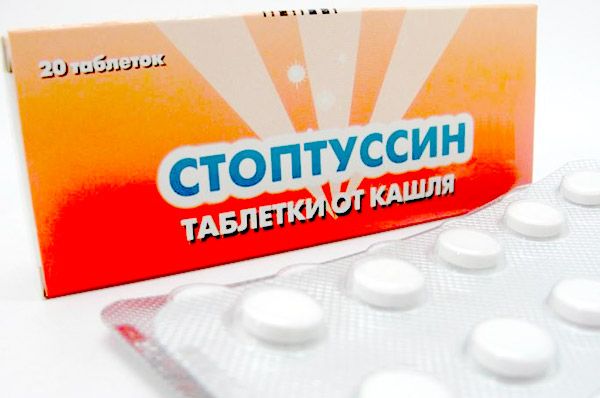
Pharmacokinetics. The drug is well absorbed by the gastrointestinal tract. Butamirate citrate binds to plasma proteins by 94%. It is metabolized by the liver. The metabolites formed during the transformation of the drug have an antitussive effect. It is excreted from the body mainly by the kidneys and to a small extent by the intestines. The half-life is 6 hours.
Orally administered guaifenesin easily and quickly enters the bloodstream from the digestive system. A small amount binds to plasma proteins. The kidneys remove the products of metabolism. The half-life is 60 minutes.
Method of administration. Stoptusin is taken after meals, without chewing, with a sufficient amount of liquid. The drug is taken at intervals of 4-6 hours.
The dose of Stoptussin tablets directly depends on the patient's body weight, but despite this, it is prescribed 3 times a day in all age groups. The exception is the group of patients weighing up to 50 kg (4 times a day). For children over 12 years old and adults, the following doses are recommended for one dose: up to 50 kg - half a tablet; 50-70 kg - 1 tablet; 70-90 kg - 1.5 tablets; more than 90 kg - 2 tablets.
Overdose. Accidental ingestion of a large amount of the drug leads to toxic effects of guaifenesin - nausea, vomiting, weakness, decreased blood pressure, dizziness, lethargy, drowsiness. Therapeutic actions are as follows: gastric lavage, intake of enterosorbents and therapy aimed at eliminating the symptom complex. There is no specific antidote to guaifenesin.
Interaction with other drugs. The active substance guaifenesin enhances the analgesic effects of paracetamol, aspirin, anesthetics affecting the central nervous system. The effect of psycholeptics and sleeping pills when taken simultaneously with Stoptusin is significantly enhanced.
When conducting urine tests using the photometric method with hydroxynitrosone-phthalene, false positive reactions may be obtained. Avoid driving vehicles due to the side effects of Stoptusin - drowsiness, dizziness. Do not use simultaneously with expectorants due to possible bronchospasm, stagnation of sputum, its infection and the development of pneumonia.
Ambrobene
The main active ingredient of Ambrobene is ambroxol hydrochloride. It increases the secretion of the glands of the bronchial tree and activates the release of surfactant in the pulmonary alveoli, which significantly contributes to the increase in the rheological properties of sputum, making it possible to improve expectoration. The effect of mucus on the ciliated epithelium of the bronchi contributes to the activation of the secretomotor effect.
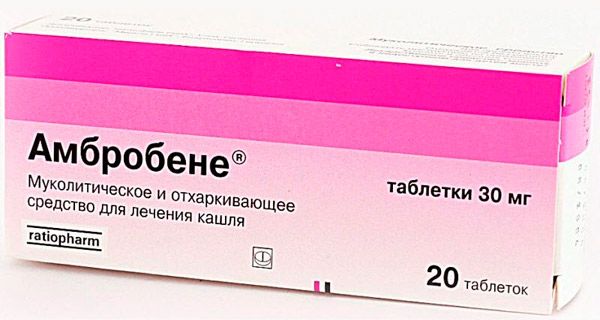
The effect begins within half an hour after taking and lasts 6-12 hours.
Pharmacokinetics. Absorbed in the gastrointestinal tract. The greatest amount in the blood plasma appears within 1-3 hours. Metabolized by the liver. The kidneys excrete metabolites. Easily overcomes the placental barrier, has the ability to penetrate into breast milk and cerebrospinal fluid. Impaired renal function leads to a slower excretion of the substance. The period of final excretion of water-soluble metabolites is 22 hours.
Method of administration and dosage: children aged 6 to 12 years, 0.5 tablets (15 mg) 2-3 times a day. For 2-3 days, 1 tablet (30 mg) is prescribed three times a day. If the dosage is insufficient and ambroxol therapy is ineffective, the dosage can be increased to 4 tablets/day and divided into two doses. After 3 days, the intake is limited to 1 tablet 2 times a day. The duration of therapy is determined by the doctor. The tablets are not chewed. Swallow after meals and wash down with plenty of liquid.
Overdose. Severe intoxication due to poisoning with ambroxol in large quantities has not occurred. The following are noted: neurological agitation, attacks of nausea and vomiting, decreased blood pressure, hypersalivation. Overdose treatment should be carried out no later than 1-2 hours later by gastric lavage and taking enterosorbents. Subsequently, symptomatic therapy is carried out in a medical institution.
Interaction with other drugs. Not used simultaneously with medications that suppress the cough center due to the risk of stagnation and additional infection of mucus. Increases the concentration of ambroxol in bronchial secretions, increasing the effectiveness of therapeutic measures. Does not affect the ability to concentrate and drive vehicles.
Cough tablets for bronchitis have contraindications and side effects.
Contraindications to taking cough tablets for bronchitis. In this group of drugs, the main contraindications are: hypersensitivity to the components of tablets; gastric ulcer and / or duodenal ulcer; pregnancy up to 28 weeks; lactation period, convulsive readiness syndrome, diseases with impaired motor and kinetic function of the bronchi, large volumes of secreted mucus. The age of childhood, from which the use of tablets for bronchitis is allowed, varies from 6 to 18 years, depending on the drug. Syrup is provided for children.
Side effects. Allergy manifests itself in the form of urticaria, exanthema, itching, dyspnea, Quincke's edema, anaphylactic shock. Regarding the gastrointestinal tract - nausea, dryness of the mucous membranes of the mouth. In rare cases, fever, weakness, cephalgia, diarrhea, rhinorrhea may appear. Affects the results of doping control.
The use of the above-described tablets during pregnancy is not recommended, especially in the 1st trimester (up to 28 weeks). There is no data on possible teratogenic effects on the fetus. In the 2nd and 3rd trimesters, the use of some tablets is rational if the benefit to the mother's body outweighs the potential danger to the fetus.
Storage conditions for cough tablets for bronchitis. No specific conditions are required. Store the preparations in a dry, dark place with an air temperature of 15-25 °C.
The shelf life is from 1 to 5 years. Depends on the components included in the preparations. After the expiration date indicated on the original factory cardboard packaging, as well as the blister, the use of the preparation is dangerous.
Antiviral tablets for bronchitis
Bronchitis, along with bacterial flora, can be caused by various viruses. Viruses from the upper respiratory tract enter the bronchi with the air flow. They are fixed there and actively multiply, damaging the mucous membrane. Because of this, the body's defense system becomes more vulnerable. The main route of transmission of viral bronchitis is contact, airborne. Bronchitis always has a viral onset and then, due to improper therapy or in the absence of a positive immune response in the patient, it becomes bacterial. At this stage, the use of antiviral tablets is rational.
 [ 5 ]
[ 5 ]
Amiksin
Active ingredient – Tiloronum. Amiksin is an antiviral drug. It has a stimulating effect on bone marrow stem cells, enhances antibody production, and increases the resistance of the immune system.
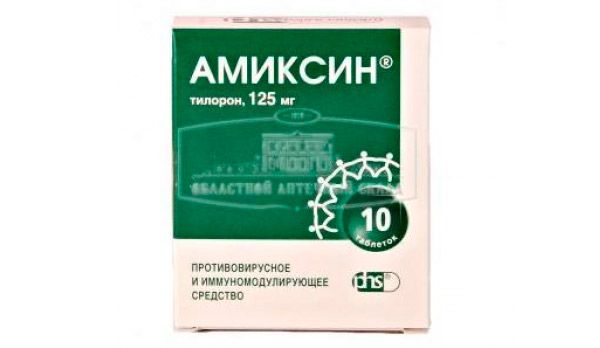
Pharmacokinetics. Absorbed by the intestine. Not subject to biotransformation. Excreted through the intestine, a small part is excreted by the kidneys. The period of maximum generation of interferon is 4-24 hours. Half-life occurs over 2 days.
Use during pregnancy. There is no experience of using Amiksin during gestation, so it is not recommended to use it during this period.
Method of use and dosage. Take orally after meals. The course of therapy with Amiksin and the schedule for taking Amiksin are determined by the doctor.
Therapy for bronchitis, acute respiratory viral infections, and influenza: adults - 125 mg during the first 2 days of therapy; then 125 mg every other day; course - 750 mg. For preventive purposes (acute respiratory viral infections, influenza): adults - 125 mg once a week for 1.5 months.
For the treatment of uncomplicated forms of influenza, acute respiratory viral infections in children over 7 years of age, according to the instructions - 60 mg 1 time per day on the 1st day and then every other day until the 4th day from the start of treatment. The course is 180 mg. For viral bronchitis resulting from complications of some forms of influenza, acute respiratory viral infections, 60 mg is prescribed once a day on the 1st day, and then every other day until the 6th day from the onset of the disease. The course dose is 240 mg.
Interaction with other medications. Good compatibility with antibiotics and drugs used in traditional therapy of diseases of viral or bacterial origin.
Arbidol
The active substance is arbidol. The drug has an antiviral effect, immunostimulating and immunomodulating effects. The active substance specifically affects viruses, activating humoral and cellular immunity. Arbidol easily penetrates cells and intercellular space. Affects the increase in interferon production.
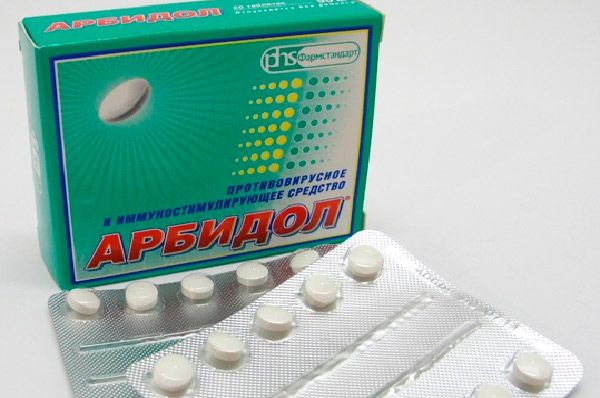
Pharmacokinetics. Easily absorbed throughout the gastrointestinal tract, distributed throughout all organs, systems and tissues of the body. Cmax is reached in 60-90 minutes. Metabolized by the liver. Excreted by the intestines, a small portion by the kidneys. Excretion time is 17-21 hours.
Method of administration and dosage. Abridol tablets are taken orally with a sufficient amount of water before meals (1-0.5 hours). Significantly increases the body's resistance to viral infections.
Therapeutic therapy. Uncomplicated acute respiratory viral infections or flu - a single dose is: children 3-6 years old - 50 mg, children 6-12 years old - 100 mg. Children over 12 years old and adults - 200 mg. Apply at intervals of 6 hours for 5 days.
Flu or acute respiratory viral infection with complications. Children 3-6 years old – 50 mg, children 6-12 – 100 mg, children over 12 years old and adults – 200 mg.
For prophylactic purposes during the spread of flu, respiratory diseases, to prevent the harmful effects of chronic bronchitis - children 2-6 years old - 50 mg; 6-12 years old - 100 mg; children from 12 years old and adults - 200 mg twice a week for 3 weeks.
 [ 6 ]
[ 6 ]
Rimantadine
Tricyclic amine. The active substance is rimantadine. It has activity against many types of viruses. At the initial stages, it blocks the replication of the virus and counteracts the appearance of new virions. It is used both for prophylactic purposes and for the initial treatment of influenza in adults and children (from 7 years old).
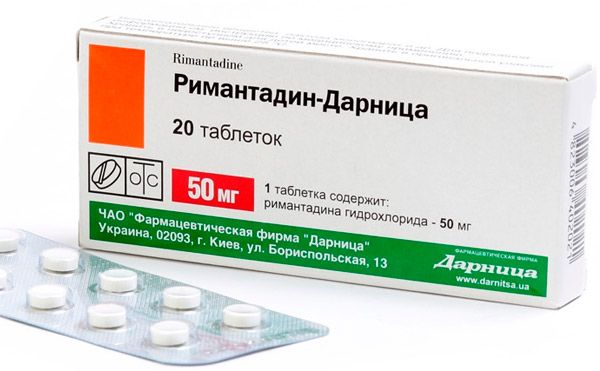
Pharmacokinetics. Absorbed in the gastrointestinal tract. Binds to plasma proteins. Metabolized by the liver. The main part of transformed metabolites is excreted by the kidneys.
Method of administration and dosage. Depending on the indications, age, dosage and treatment regimen are prescribed individually.
Interaction. Taking medications containing Acidum acetylsalicylicum or Paracetamolum reduces the concentration of rimantadine. Cimetidine - decreases the clearance of rimantadine.
Amizon
Non-narcotic analgesic, antiviral drug. The active ingredient is amizone, which is a product of para-pyridinecarboxylic acid.
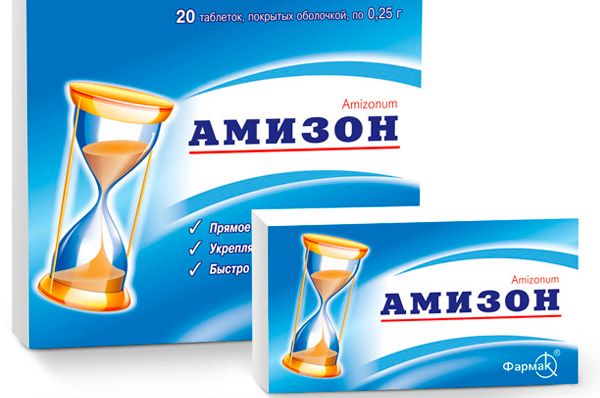
Inhibits the action of influenza viruses. Strengthens the body's resistance to viral infections, has antiphlogistic, antipyretic and analgesic effects.
Pharmacokinetics. Through the gastrointestinal tract, it enters the systemic bloodstream, reaching its highest values within 2-2.5 hours. Metabolized by the liver. Excreted in the urine.
It is used for the prevention and treatment of influenza, viral respiratory infections, as a component of complex therapy for viral, viral-bacterial pneumonia and tonsillitis.
Taken orally after meals. Maximum single dose is 1 g, throughout the day - 2 g. For the treatment of influenza and acute respiratory viral infections, 0.25-0.5 g 2-4 times a day (5-7 days). Children aged 6-12 years, 0.12 g 2-3 times a day (5-7 days).
To prevent flu:
- adults – 0.25 g per day (3-5 days), then – 0.25 g once every 2-3 days (2-3 weeks);
- children 6-12 years old – 0.125 g every other day (2-3 weeks);
- adolescents from 12 to 16 years old – 0.25 g every other day (2-3 weeks).
Interaction with other drugs. When used simultaneously with antibacterial drugs, amizon enhances their effect. It is prescribed in parallel with drugs containing ascorbic acid, as well as recombinant interferon.
Contraindications. The drugs are well tolerated. The exceptions are patients with liver and kidney pathologies, with individual hypersensitivity to the ingredients of the tablets, childhood (from 3 to 7 years). Taking during pregnancy and lactation is not advisable.
Side effects of antiviral tablets for bronchitis. Allergic manifestations are practically absent and disappear when the tablets are discontinued. They do not affect the ability to drive vehicles and operate machinery.
Storage conditions for bronchitis tablets. The above-described medications are stored in the usual way (in a dark and dry place with an air temperature of no more than 25 °C).
The shelf life varies from 2 to 3 years.
 [ 7 ]
[ 7 ]
Antibiotics for bronchitis in tablets
To accelerate the therapeutic effect during the period of exacerbation of chronic bronchitis, antibiotic therapy is indicated. The recommendation of the drug depends on the type of pathogen.
In case of a long-term course of bronchial disease, antibiotics and combination medications are prescribed in the acute phase of purulent bronchitis. Antibiotic therapy is carried out in courses of 7 to 10 days. In case of a long period of exacerbation, the course is increased to 0.5 months.
List of tablet medications used to treat bronchitis:
- Amoxiclav.
- Ceftriaxone.
- Spiramycin.
- Sumamed.
- Ciprofloxacin.
- Amikacin.
- Gentamicin.
Expectorant tablets for bronchitis
A wet cough is accompanied by phlegm, which is best gotten rid of. This type of cough will stop when all the phlegm is gone.
The following expectorant tablets are used during the treatment of productive cough for bronchitis:
- ACC (acetylcysteine).
- Bromhexidine.
- Flavamed.
- Mucaltin.
Tablets for obstructive bronchitis
Obstructive bronchitis is a disease of the bronchial tree caused by inflammatory processes. In this situation, phlegm accumulates and does not find a way out. Patients are forced to cough constantly.
There are acute and chronic forms of the disease. Acute obstructive bronchitis is typical for childhood. The main causes are: acute respiratory viral infections, influenza; adeno- and rhinoviruses; RSV infection.
Chronic bronchitis affects the adult population of the planet, more often the elderly. Causes: smoking, hereditary-genetic pathology, unfavorable environmental conditions, work in hazardous industries (metalworking, coal mines, etc.).
Treatment of obstructive bronchitis is aimed at relieving bronchial spasm, reducing viscosity and removing sputum.
Tablets for obstructive bronchitis:
- Bronchodilators - anticholinergics; xanthines; beta-adrenergic agonists.
- Drugs containing hormones (prednisolone);
- Sputum thinners – ambroxol; acetylcysteine; bromhexine.
In the treatment of obstructive bronchitis, antibiotics of the fluoroquinolone group; macrolides; aminopenicillins, if a bacterial infection is observed, are indicated.
For successful treatment of chronic obstructive bronchitis, the patient needs to change his lifestyle.
Effective tablets for bronchitis
The selection of effective tablets used for the treatment of bronchitis depends on the nature of the cough. Cough can be productive or unproductive, arising as a symptom of another disease.
Identifying and treating the cause of the cough is the key to a successful and quick recovery.
Therapy for different types of cough has its own characteristics. When treating dry cough, drugs are used that help stop the cough reflex. These drugs are prohibited when treating wet cough, which can cause bronchial obstruction.
To select effective tablets for bronchitis, it is essential to consult a doctor.
 [ 12 ]
[ 12 ]
ATC classification
Pharmacological group
Pharmachologic effect
Attention!
To simplify the perception of information, this instruction for use of the drug "Bronchitis pills" translated and presented in a special form on the basis of the official instructions for medical use of the drug. Before use read the annotation that came directly to medicines.
Description provided for informational purposes and is not a guide to self-healing. The need for this drug, the purpose of the treatment regimen, methods and dose of the drug is determined solely by the attending physician. Self-medication is dangerous for your health.

